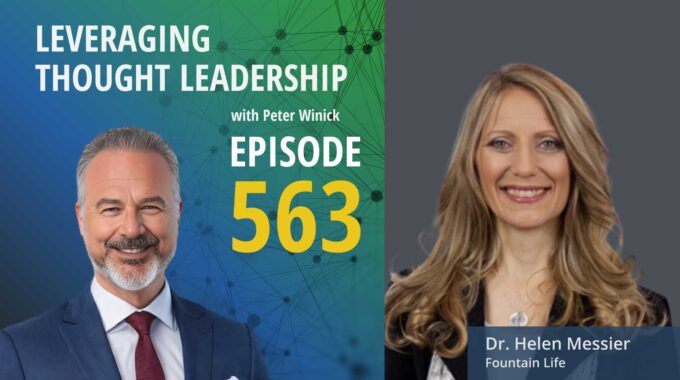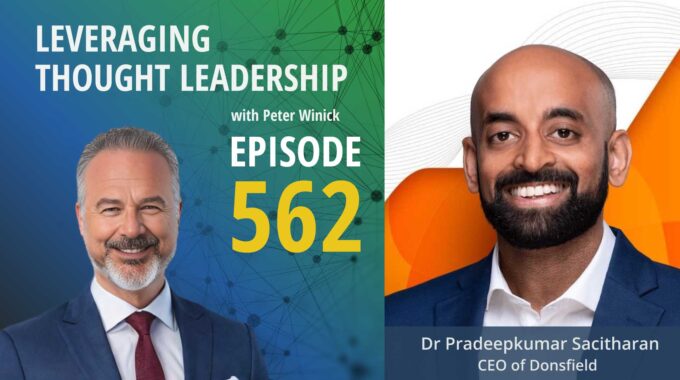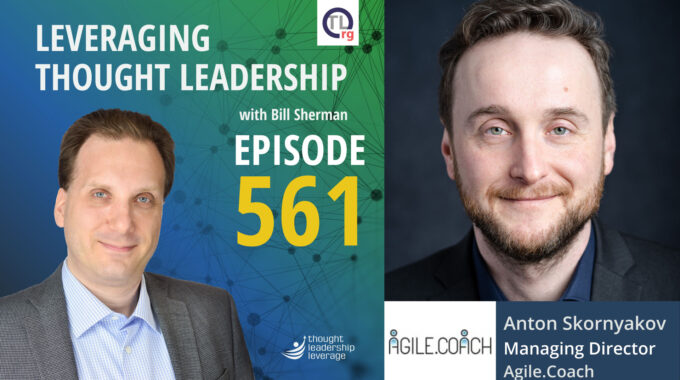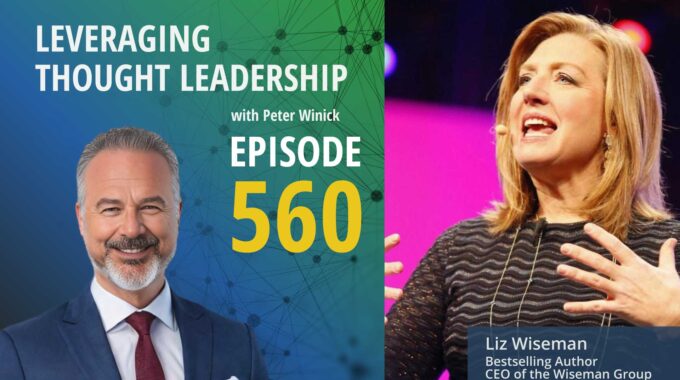Strategies for Shaping the Future of Healthcare A conversation with Dr. Helen Messier about what…
The Innovation Mindset | Jennifer Kenny
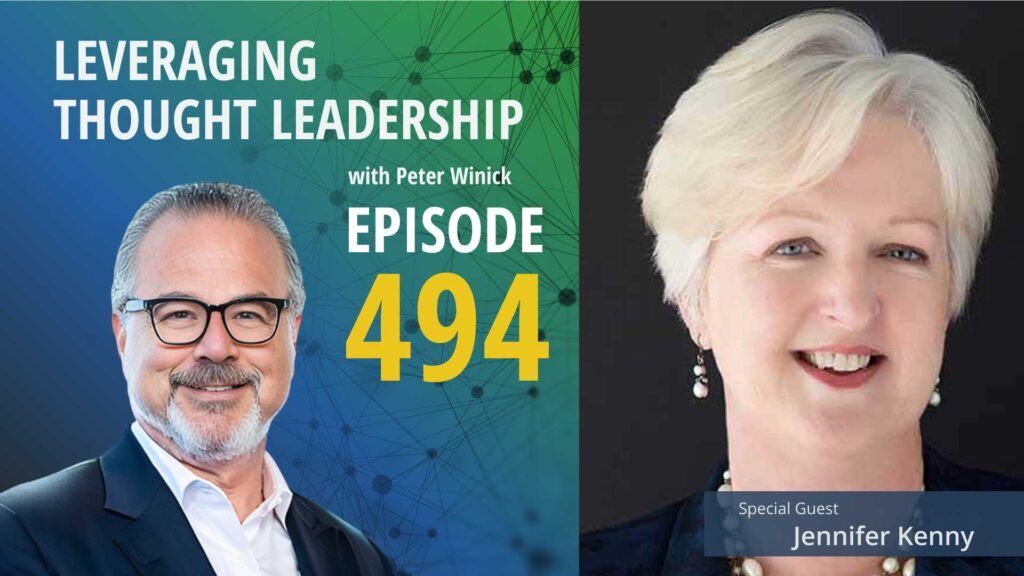
Innovation in consulting and authoring.
An interview with Jennifer Kenny about the concepts and process of writing her book The Innovation Mindset.
Consultants often approach clients seeking to answer the question, “How can I help you?”
What would happen if you instead asked, “What can you and I create together, to solve the problem?”
Our guest today is Jennifer Kenny. Jennifer is a speaker, technology leader, strategic advisor, and bestselling author of “The Innovation Mindset: A Proven Method to Fuel Performance and Results”
Jennifer shares with us how her career started out in geology, where she delved into the depths of systems thinking. Those practices, built to support her scientific hypotheses, led her to consulting and developing her own content. Jennifer’s innovative attitude to solving problems by using a mastery of coordination, communication, and co-creation of solutions elevated her approach, and allowed her and her clients to overcome complex challenges.
One problem that was not easily solved was writing her bestselling book, The Innovation Mindset. Jennifer tells us how the book started with an entirely different focus before getting scrapped for a second iteration… which she also discarded! Through conversation with Page Two Publishing, Jennifer realized that she should be focusing on innovation and collaborative ideas – and thus, her book was born.
In addition, Jennifer talks about the huge learning curve that exists in the publishing industry, and how she worked with her daughter to enhance her own capabilities and create an incredible book!
Three Key Takeaways:
- If you are going to share your mastery of a complex field or system, you need to make it easy for your audience to understand your insights.
- Aspiring authors should find a good editor that can elevate a manuscript to its full potential.
- If you are going to write with a partner, you need to understand the intricacies of collaboration – and communication!
If you need a strategy to bring your thought leadership to market, Thought Leadership Leverage can assist you! Contact us for more information. In addition, we can help you implement marketing, research, and sales. Let us help you so you can devote yourself to what you do best.

Transcript
Peter Winick And welcome, welcome, welcome. This is Peter Winnick. I’m the founder and CEO at Thought Leadership Leverage and you’re joining us on the podcast today, which is leveraging thought leadership. And today my guest is Jennifer Kenny. She is the author of as of 5 minutes ago, the best selling book, The Innovation Mindset. So she just shared that with me before we recorded. So congratulations. She’s a master of innovation practices. She increases the capacity of leaders, teams and organizations to fuel innovation, performance and revenue in complex and emergent technology ecosystems. So without getting into the rest of her bio, which is quite impressive, she’s sitting right here in front of me, so I’d rather just talk to her. So welcome, Jennifer, How are you? And congratulations.
Jennifer Kenny Thank you very much. I’m very well. I’m delighted the book because, you know, books take a long time to give. But yeah, so it’s finally out there in the world. And the people I wrote it for seem to be excited and we’ve done, you know, Amazon but still number one in a couple of different categories and we’re pretty pleased.
Peter Winick Fantastic. So let me ask you this. You know, so as I peruse your bio, you know, undergrad in Dublin, Masters in London, you’ve been at Accenture, you’ve been Abus, etc., etc.. So that’s a logical career path, right? What’s your journey and path been like if you were to write a resume of, you know, Jennifer, the thought leader? What might what would the highlight reel say?
Jennifer Kenny So it starts off as a geologist, which is the ultimate in systems thinking. And I loved that because it was systems thinking. And then I went on to demonstrate and geotech and all of that. And I think what I’ve been doing, if I look back on this, I’ve been following the systems, thinking right for my entire career. The idea that you are looking to really understand complex adaptive systems and, you know, human beings ourselves, we are complex adaptive systems. And yes, the way that we have chosen historically to look at the world is to look at it as a linear hierarchical system. And I think we’re seeing that absolutely fall apart all around us at the moment. So the people who are systems thinkers and able to think like systems thinkers and have this to support their systems thinking are the ones who tend to be most transformational, most innovative, most adaptive. And so that’s what I love doing, and that’s what I bring into companies.
Peter Winick I love that. Tell me how you started, right? So how did you start as a because today you’re sitting here as a multiple published author. You have this expertise on the innovation mindset. How did that path start? Because obviously when you were at places like Booth and Accenture, it felt like you have lots of idle time. Right. It’s magic.
Jennifer Kenny Time.
Peter Winick So how was your journey, your path as a as a thought leader, where did it start and how did it evolve?
Jennifer Kenny Yeah, I think thank you. Yeah, I think it started doing consulting because I felt that consulting was always a how can I help you type of conversation? And I wasn’t particularly interested in those. I’m much more interested in the What can I co-invest with you? What can I bring to the table from my respective expertise and from yours? And I would even say not expertise, but mastery. So I said I was in pursuit of mastery in a particular area. And the wonderful thing about that is it’s an incredibly humbling experience because you can only aspire to mastery in a timing niche of human understanding. And so you go through this process, which I refer to as the tiny nub of nothingness, where you really say, Really, that’s who I’m going to be, that’s what I’m going to be known for. And you strip off all of the other identities that you have and you come back and you go innovation practices. That’s going to be my thing. And then you start building out your body of work in that space. And I’ve been doing that now for probably about 15 years in various different, you know, with various different elements of. This is something obviously a big part of it. Yep. And so it’s so it’s that process of really understanding where you’re going to stand your ground, what you want to be identified for, what matters to you. And what mattered to me because I saw so much difficulty and suffering around us, brilliant people, helping them be able to move beyond what they would refer to as the politics of organizations and actually be able to get to the real work that they’re there to do, which is the work of innovation and co invention. And that’s where I play.
Peter Winick Interesting. So I like that you’ve got sort of the innovation, what did you call it, the innovation principles, sort of the starting platform.
Jennifer Kenny Yeah. So the innovation practices.
Peter Winick Innovation practices stay there for a minute because if that’s your platform, the world now knows you knows Jennifer as the innovation practices woman. Then what that does is it serves as sort of a constraint in a good way, right? So the fact that your latest book is called Innovation Mindset, that that logically fits under that it’s an extension of it makes sense. And then there’s lots of things that you’ve probably toiled with or thought about as an entrepreneur and such. That said, yeah, that might be cool, I might be above average and that I might even be an expert at that, but it doesn’t fit, so therefore I shouldn’t go down that that takes a tremendous amount of discipline to say no to something that you’re actually really good at. Can you touch on that for a moment?
Jennifer Kenny Yeah, that’s a great question. So this is again, my time, you know, with nothingness, because I think that once you look to position yourself, you really you have to be able to make it easy for people to understand what you’re standing on, what ground you’re standing on, what area you’re really practicing in. And innovation practices is something that most people can relate to. They don’t necessarily understand it. They don’t necessarily know how to implement it. They don’t necessarily even know what it is, but they can relate to it. And that’s all I was looking for. And so for me, staying with clarity and precision in that space and saying when it comes to innovation mindsets, when it comes to how we practice, it goes to the type of teams we need to build in order to be sure when it comes to the kind of time. Diversity. We need to be able to understand how to build truly innovative teams. Those are the areas that I’m going to play. And when it comes to the communities we need to build to be able to innovate together. I’m going to play there. And so it is really a process of going. There are so many other things. I mean, there’s so many other things I would love to short list because I want to work in, but I am really and the equivalent, I guess, from a product perspective would be product led growth. I got a request last week to work with a group of people who are working in the regenerative economy or the circular economy. Sure. Now, that’s an area that I’m fascinated by and that I, you know, I know is terribly important. And I want to work with teams in the space for sure. But to be invited to do something in space is now that I will allow in terms of it doesn’t mess with my positioning and how I want to be identified, it actually enhances it because it’s a wonderful invitation. So that’s more how I’m looking at it is it’s like you position yourself and then you look for who are the people who relate very strongly to that and how can you add value for them?
Peter Winick Love it. That makes sense. One, I like how you’re sort of staying in your lane and also giving yourself some freedom because otherwise you get bored, right? Like if you’re only doing the exact same thing. So there’s going to be places where you have to make some strategic decisions around where the boundaries are and boundaries change, borders, change, all that sort of stuff.
Peter Winick If you’re enjoying this episode of Thought leadership leverage, please make sure to subscribe. If you’d like to help spread the word about our podcast, please leave a five star review at ratethispodcast.com/ltl and share it with your friends. We’re available on Apple Podcasts and on all major listening apps as well as that thought leadership leverage dot com forward slash podcast.
Peter Winick I want to you and I were talking before we hit record here about the book process, right? So let’s go back now. So now you’re in this sort of early launch period. Let’s go back to when the book was an inkling, a seed of an idea. Right. And walk us through how it’s evolved and were devolved or like how did it go from the ideation piece to thump? It could land on my desk now.
Jennifer Kenny Yeah. So it actually was started off with another book, which is going to be now my third book. It started off with that one and I think I wrote and that one was very much focused on how more gender diverse teams are, more innovative. And there’s plenty of data out there on that now, but nobody really. You know, companies struggle with how do you do that? And I had done a lot of research and work in that space. So I wrote book number one. I’m like, there we go. This is this is fabulous. And I read it myself. And I was I don’t really want to.
Peter Winick Publish that so much. Yeah, right. Oh, my name is another iteration.
Jennifer Kenny Exactly. There’s another iteration from another angle I’m still not happy with. And then I was I spoke to page two who’ve done the publishing, and they’re just incredible. And they said to me, What kind of book do you want to write? Jennifer? And I said, I’d like to write a book I’m not embarrassed about. And they said, Well, we think we could move the bar a little higher than that one gender. So we decided to do this innovation mindset one, because that’s the one that I am. I have, you know, most of my businesses in that I have 30 years of experience. And so this one was an easier one for me to put together. And now going through the entire process has positioned me to be able to do the next one and the next one’s going to be picked up by Macmillan. So we’re now in the process. We submitted the manuscript. We’re now in the process of doing all of that. So the process is it’s a huge learning curve. Peter It’s just I was blown away at what a big learning curve it was and the whole publishing industry, unless you’ve been involved with it in some way previously, it is it is quite a unique industry and the only thing I would say to aspiring authors is get yourself a really good editor because they can make your ugly baby look beautiful.
Peter Winick Yeah, well, and there’s lots of it’s a classic example of it takes a village. Everybody thinks like what is a more loner type activity? Write a book like write it as, you know, lock yourself in a cabin and you know, la la la la. But from the editorial to the design to the marketing to the district, I mean, there’s multiple layers that are so outside the core competencies of a typical writer.
Jennifer Kenny Yeah, absolutely. And then even I wouldn’t consider myself a typical writer at all. Someone said to write, I need to write a book. And I said, Well, it’s a very long term strategy. Gave book. I gave birth to an author and got her to help me. 28 years later, I got her now because I happened to have a daughter who’s much more into the story in the detail than I am.
Peter Winick I’m Maria. But stay there a moment, though, because I think there’s some something interesting. I don’t know if I recommend I recommend a 28 year gestation period, but the fact that you’ve got the expertise that your daughter doesn’t, she may be a better quote writer when we look at it through the lens of storytelling or whatever. And I think that oftentimes what happens is an amazing expert write a great thought leader needs someone, whether that’s, you know, ghostwriters. To me, there’s a continuum of is it really an intellectual sparring partner? Is it a wordsmith? Is it someone that’s actually trying to capture your voice and you’re lazy and don’t actually want to write? Like, where do you want that to be? What’s the right fit for you? So I’m assuming, yeah, or she probably knew your voice and style and was probably somewhat familiar with the work. So the, the onboarding period, some would say would be like some would say it was 28 years. We could debate that.
Jennifer Kenny Right? Yeah, I know. Fantastic. I think distinctions to lay out for people is so for me, what it was, I didn’t want an intellectual sparring partner. I’d already had loads of those. They were all my clients and they’re fabulous, all great in that department. I didn’t I wasn’t too lazy to write a book because God knows I’d taken the name from the best thing. And so what I needed was I needed someone to enhance my particular capacity with their own and my job very, very different. And it worked out as a really, really nice partnership and we had fun doing it. So I think it’s for me, you know, speaking to anyone who’s thinking about doing this, for me, it’s a process of, you know, what are you missing and how do you find it? Because ultimately the book has to be a gift for the people who you want to read us. And that’s what I was hoping. That’s what I was aiming.
Peter Winick So now that we talked about the energy and the effort and the work and, you know, we’re all about to actually write a book, let’s talk about the hard part, right? So the hard part is how do you get the book in front of anybody that cares, right? Like, how do you know, to me, it feels like, you know, maybe I’m old school. I like to read a lot. I actually read a couple of books a week. But like, yeah, for the most part, how do you get people out of their trance and get the most precious resource and commodity that we have today, which is undivided attention for a moment in time for them to look at your stuff and say, Oh yeah, yeah, maybe I should buy that book, maybe I should read that book. Has How’s that going?
Jennifer Kenny Yeah, So that was I was amazed with that. So one is people actually look at the cover much more than they look at the interior before they buy a book. So I have a really beautiful cover. Thank you. Yes. But the other thing that I think is really important, and I’m certain you do the same thing when I pick up a book, I read the endorsements to see whether or not it’s something I’m interested in. So I got an enormous gift from Gill, who’s Toyota’s chief scientist, and he wrote me an endorsement. And he said, I strongly recommend the innovation mindset to anyone who wants to learn how to do the more challenging part of innovation. Now, if anyone understands a more challenging part of innovation, Gail Pratt does the transformation by human teams of inventions into innovations. So for me, if I’m walking through the airports and I see that and I’m interested in the innovation, I’m buying this book anyway. So I think you’re endorsements are really, really important. And then also Wolfram Burghardt, who literally wrote the Bible on probabilistic robotics, also gave me one. Thank you. Wolfram And he said the innovation mindset provides a unique view on how to improve human collaboration in support of greater innovation.
Peter Winick So let me let me let me push on you a little bit there. Yeah, a couple of things. So this’ll be fun. One is the use case that you described someone walking through an airport or bookstore and picking up a book, physically picking up a hard copy of the book, looking at a beautiful cover, looking at the back, a look at the endorsements. There’s some truth to that. But that’s not the way most people buy books most often today. Over 60% of books sold are digital right now. So now it’s they’re looking at a thumbnail of a book cover. So a good book cover is better than a not good book cover up. But if I’m looking at it while standing at Starbucks, you know, I, you know, thumbnail size on my phone while ordering a cappuccino, it’s less influential. Am I really double clicking and looking at all that to find the testimonials? Right. That’s a different that’s one use case of I would call it a little bit more old school like that. It used to be my favorite thing to do is walk through the aisles of a Barnes and Noble with a piping hot cup of coffee and say, Hey, I never heard of this Kenny lady, who the hell is she? And then, Oh, look at what all these other brilliant people said. Like, okay, you got me. I’m going to take that to the register today. We need to basically get the people that endorse us from a testimonial perspective and get them to make some noise in their communities. Right. Because those folks that you mentioned, they gave you something beautiful, but their names are only relevant to a certain population. So we want them to go back to their followers and say, Hey, my friend Jennifer wrote this awesome book. In fact, it’s so great. Here’s what I said about it. You know, and maybe there’s a hyperlink maybe that’s in their newsletter or on a social feed or whatever. I think we just need to be multi-channel today.
Jennifer Kenny And yeah, I totally agree. And I think it would take something even more organic than that. I think a lot of it is word of mouth. I mean, most of us now read books based on people who we know or like or follow who are for whoever.
Peter Winick Exactly. Right. Exactly.
Jennifer Kenny And so I think one of the things that I did in there in this intentionally with that in mind is that I worked to make this as pragmatic as possible. So I my editor said to me, Jennifer, you know, this book could be a perpetually youthful book. So, you know, the books that you put all the little sticky tags into.
Peter Winick Yeah, I remember.
Jennifer Kenny You use them a hundred times like I have one of them. Here it is. It’s a mess. But I love it, right? Because it’s got multiple different sticky tags of all different ages, sizes and colors. And I just loved the idea of being able to do that. So what I put in here was there’s practices and exercises for people. There’s exercises for them in their teams. There’s ways they can look to apply stuff immediately. You know, nothing is just theoretical. Everything is there’s practical models, there’s practical applications, there’s applications for you, applications for your team. And so what I wanted to do was write something that people would put sticky notes in and, you know, write notes in the margins. I didn’t want to write the perfect.
Peter Winick Maybe there’s a good marketing ideas to sell a hardcover book that comes with a good three MB to sponsor with a shrink wrap, a pack of yellow stickers and a and a colored marker with it. That might be exactly. I mean.
Jennifer Kenny That’s what I was looking for. It’s like to me, the most valuable books are the ones that blow my mind, and I get one fabulous idea so that when I walk away and I’m good to go, are the ones that sit on my desk covered in sticky notes and that I wave at my zoom screen every so often don’t recommend other people. So that’s what I was. I was going for the latter. And hopefully as people applied like I got a lovely email from a woman the other day and she said, Look, I’ve started applying this already. I get that the innovation mindset applies in everything that I do. I’ve got a really important next meeting this week. I want to apply this stuff. So that’s when that’s what I was looking to do now.
Peter Winick And I think that’s the world that we’re living in, in that it used to be we would take on information for the sake of learning, which is what lots of people still do that. But also there’s this whole this, you know, in the moment on demand, you know, do it yourself YouTube mentality of, yeah, I’ve got this meeting tomorrow or I’ve got this client I’m working with. Today. So it drives the need really, really from the center where you know that there’s a little bit of pressure and a use case. So it’s not theoretical. It seems like people don’t have the bandwidth to learn something that they may use at some point in time. It’s like there needs to be the forced pressure of a deadline or something coming up that increases the odds of that happening.
Jennifer Kenny Yeah, agreed. And I think it’s a bit of a luxury to find the time to be able to do that. And I hope.
Peter Winick Yeah.
Jennifer Kenny But I also think that, you know, for me it’s super respectful to meet people where they’re at. And I want to tell the people I’m writing for, I have full time jobs, have families, have communication is totally hard, and if I’m not adding value for them immediately, well then, you know, I’m not respecting them. So that’s what I was aiming to do.
Peter Winick Yeah, No. Well, well said. Well, this has been phenomenal. I appreciate your time. Appreciate the effort and good luck on the future success and launch of the book. Thank you so much, Jennifer.
Jennifer Kenny Thank you. Take care, Peter. Thank you.
Peter Winick To learn more about thought leadership leverage, please visit our Web site at fault leadership leverage dot com to reach me directly. Feel free to email me at Peter at thoughtleadershipleverage.com and please subscribe to leveraging thought leadership on iTunes or your favorite podcast app to get your weekly episode automatically.


